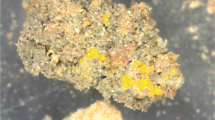Abstract.
Several case studies are described, all focussing on the analysis of archaeological objects. Research was done on objects from different materials, such as glass, textile and ceramics, from different pre-historical contexts and addressing different questions. In all cases, however, the analytical procedure was complex due to the nature of the archaeological material. We discuss the possibilities and limitations of different non-destructive and micro-destructives techniques.
Similar content being viewed by others
References
Freestone I C (2001) Post-depositional changes in archaeological ceramics and glasses. In: Brothwell D R, Pollard A M. Handbook of archaeological sciences, vol. 615–625. Wiley Interscience, p 3, 15 and 4
R G Newton S Davidson (1989) Conservation of glass Butterworths London 318
R G Newton (1984) ArticleTitleThe durability of glass, a review Glass Technol 26 21
J E Shelby (1997) Introduction to glass science and technology The Royal Society of Chemistry Letchworth 244
T De Groot (2006) ArticleTitleResultaten van de opgraving van een Romeins tumulusgraf in Bocholtz (gem. Simpelveld) Reeks Archaeologische Monumentenzorg, Rijksdienst voor het Oudheidkundig Bodemonderzoek, Amersfoort 127 171
Huisman D J, Pols S, Joosten I, van Os B J H, Smit A (2007) Degradation processes in colourless Roman glass: cases from the Bocholtz burial (in press)
J Henderson (1988) ArticleTitleElectron probe microanalysis of mixed alkali-glass Archaeometry 30 77 Occurrence Handle10.1111/j.1475-4754.1988.tb00436.x
A Kern (2005) ArticleTitleHallstatt – eine Einleitung zu einem sehr bemerkenswerten Ort BAR International Series 1351 1
B Bichler K Grömer R Hofmann-de keijzer A Kern H Reschreiter (2005) ArticleTitleHallstatt textiles, technical analysis, scientific investigation and experimten on iron age textiles BAR International Series 1351 i
Hofmann-de Keijzer R, van Bommel M R, Joosten I, Reschreiter H, Grömer K, Mautendorfer H, Hartl A, Morelli M (2005) Ancient textiles – recent knowledge. A multidisciplinary research project on textile fragments from the prehistoric salt mine of Hallstatt. 14th Triennial Meeting of ICOM-CC The Hague, p 920
R Hofmann-de Keijzer M R van Bommel I Joosten (2005) ArticleTitleDyestuff and element analysis on textiles from the prehistoric Salt-mines of Hallstatt BAR International Series 1351 55
M R van Bommel (2001) ArticleTitleThe analysis of dyes with HPLC coupled to photo diode array and fluorescence detection J Dyes Hist Archaeol 20 30
J Wouters A Verhecken (1989) ArticleTitleThe coccid insect dyes: HPLC and computerized diode-array analysis of dyed yarns Stud Conserv 34 189 Occurrence Handle10.2307/1506286 Occurrence Handle1:CAS:528:DyaK3cXnsF2jtQ%3D%3D
H Böhmer (2002) Koekboya, natural dyes and textiles EditionNumber1 Weppert Schweinfurt, Germany 203
J H Hofenk de Graaff (2004) The colourful past: origins, chemistry and identification of natural dyestuffs EditionNumber1 Archetype Publications London, UK 274
J H Hofenk de Graaff (2004) The colourful past: origins, chemistry and identification of natural dyestuffs EditionNumber1 Archetype Publications London, UK 214
Unpublished results. It was noted in many reference materials that an unknown yellow component usually accompanies the indigo and woad
J H Hofenk de Graaff (2004) The colourful past: origins, chemistry and identification of natural dyestuffs EditionNumber1 Archetype Publications London, UK 22
B Cooke B Lomas (1987) The evidence of wear and damage in ancient textiles P Walton J-P Wild (Eds) Textiles in northern archaeology SeriesTitleNESAT III: Textile Symposium in York 6–9 May 1987 Archetype Publications London, UK 15
D Lehmann (1997) Faseratlas: das Erkennen der textilen Faserstoffe Verlag Detlef Lehmann, Esens Germany 58
G Banik H Stachelberger K Messner (1988) ArticleTitleUntersuchung der destruktiven Wirkung von Tinten aus Schriftträgermaterialien Restauro 4 302
J H Hofenk de Graaff (2004) The colourful past: origins, chemistry and identification of natural dyestuffs EditionNumber1 Archetype Publications London, UK 396
Selih S, Strlic M, Kolar J (2003) Catalytic activity of transition metals during oxidative degradation of cellulose. In chemical technology of wood, pulp and paper, vol. 17–19, p460
H Zollinger (2003) Color chemistry. Syntheses, properties and applications of organic dyes and pigments EditionNumber3 Wiley Zürich 637
Joosten I, van Keulen H, de Groot S, de Keijzer M, van Bommel M R (2003) Materiaaltechnisch onderzoek aan Romeins aardewerk uit Ellewoutsdijk, Netherlands Institute of Cultural Heritage, Amsterdam, unpublished report
Joosten I, van Keulen H, de Groot S, Megens L (2006) Onderzoek naar beschildering op en de aanwezigheid van olie in ijzertijd aardewerk uit Geldrop, Netherlands Institute of Cultural Heritage, Amsterdam, unpublished report
Wilson A S, Tuross N, Wachowiak M J Jr (1996) Blood residues on archaeological objects – a conservation perspective. In: Roy A, Smith P. Preprints of the contributions to the Copenhagen Congress, vol. 26–30, p 213
Author information
Authors and Affiliations
Corresponding author
Additional information
Correspondence: Maarten R. van Bommel, Research Department, Netherlands Institute for Cultural Heritage, P.O. Box 76709, 1070 KA, Amsterdam, The Netherlands
Rights and permissions
About this article
Cite this article
Joosten, I., van Bommel, M. Critical evaluation of micro-chemical analysis of archaeological materials. Experiences from the Netherlands Institute for Cultural Heritage. Microchim Acta 162, 433–446 (2008). https://doi.org/10.1007/s00604-007-0828-6
Received:
Accepted:
Published:
Issue Date:
DOI: https://doi.org/10.1007/s00604-007-0828-6




